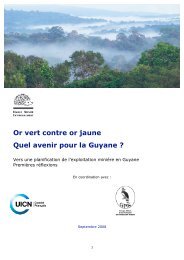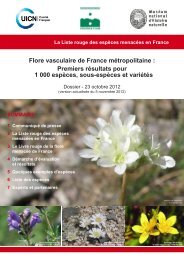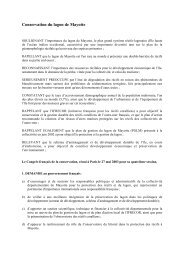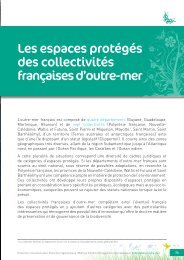Establishing Marine Protected Area Networks - Georgia Strait Alliance
Establishing Marine Protected Area Networks - Georgia Strait Alliance
Establishing Marine Protected Area Networks - Georgia Strait Alliance
You also want an ePaper? Increase the reach of your titles
YUMPU automatically turns print PDFs into web optimized ePapers that Google loves.
CONTENTS<br />
INTRODUCTION & BACKGROUND<br />
introduction and background to this report 1<br />
❏ why do we need marine protected area (mpa) networks? 2<br />
What is an MPA network?<br />
Why are MPA networks important for sustainable development?<br />
❏ what are the ecological design criteria for mpa networks? 4<br />
Representativeness<br />
Replication<br />
Viability<br />
Precautionary design<br />
Permanence<br />
Maximum connectivity<br />
Resilience<br />
Size and shape<br />
❏<br />
❏<br />
❏<br />
what are the best practices for planning and implementing<br />
mpa networks? 6<br />
Clearly define objectives<br />
Establish long-term political commitment and will<br />
Encourage stakeholder participation<br />
Make best use of available information<br />
Develop integrated management frameworks<br />
Employ adaptive management techniques<br />
what are the broader considerations needed to ensure that<br />
mpa networks are set in context? 8<br />
Economic and social considerations<br />
Spatial and temporal considerations<br />
Scientific and information management considerations<br />
Institutional and governance considerations<br />
what are the key elements needed to make mpa networks<br />
happen and achieve their goals? 12<br />
Political will and leadership<br />
Public education, communication and awareness<br />
Monitoring and assessment<br />
Sustainable financing<br />
Compliance and enforcement<br />
the next steps 16<br />
acknowledgements 16<br />
Regardless of where we live, all people depend upon healthy<br />
ocean ecosystems.The role that marine protected areas<br />
(MPAs) can play in promoting the health of our oceans and<br />
seas has been recognized at the highest levels.The World<br />
Summit on Sustainable Development, the IUCN’s World<br />
Commission on <strong>Protected</strong> <strong>Area</strong>s, the Convention on<br />
Biological Diversity, and the G8 group of Nations have all<br />
called for establishing a global system of MPA networks by<br />
the year 2012. Our challenge is to transform these commitments<br />
into meaningful action.<br />
Yet global progress on building marine protected area (MPA)<br />
networks has been slow, in part because they embrace a range<br />
of issues greater than conservation alone. For conservationists<br />
and natural resource managers, identifying the conservation<br />
actions needed to establish MPA networks can be a difficult<br />
process, but including concerns outside their immediate sphere<br />
of experience can be even more challenging and complex.This<br />
is where this report comes in. It seeks to capture emerging<br />
international best practice on the full range of considerations<br />
needed to build such networks.<br />
The following considerations are essential to developing<br />
successful MPA networks:<br />
❏ eight ecological criteria of network design;<br />
❏ six areas of best practices for establishing networks;<br />
❏ four broader considerations to help successfully embed<br />
MPA networks within a wider social context; and<br />
❏ five key elements to make MPA networks happen and<br />
achieve their goals.<br />
Key aspects of building MPA networks<br />
public education,<br />
communication<br />
& awareness<br />
monitoring<br />
& assessment<br />
Making It Happen<br />
ecological design criteria<br />
best practices for planning &<br />
implementation<br />
selling MPA networks in a broader context<br />
economic & social considerations<br />
spacial & temporal considerations<br />
scientific & information management considerations<br />
institutional & governance considerations<br />
sustainable financing<br />
political will<br />
& leadership<br />
compliance &<br />
enforcement<br />
Many of these issues are highly inter-related, but have been<br />
separated out in this report for ease of description and<br />
communication. Issues such as the need for public education<br />
and political will are pertinent throughout the process of<br />
establishing MPA networks. No sequence or hierarchy is<br />
implied; in fact, all elements included in this report are<br />
seen as fundamental to implementing MPA networks.The<br />
emphasis on particular issues will change, depending on<br />
the individual circumstances of each region or country.<br />
This summary is intended to help:<br />
❏ politicians, policy advisors and decisions makers who have<br />
a role in ensuring that policy commitments to establish MPA<br />
networks become a reality;<br />
❏ the donor community supporting work on MPA networks<br />
in assessing the importance of proposals;<br />
❏ planners, managers and other practitioners at regional,<br />
national and local levels who implement MPA networks to<br />
set their actions within a broader comprehensive setting; and<br />
❏ international organizations, especially regional seas conventions,<br />
who act as enabling bodies for implementing agreed<br />
commitments to deliver MPA networks.<br />
From this work, three things are clear:<br />
❏ no single strategy can succeed in all circumstances; rather,<br />
network designers must consider and draw from a broad<br />
matrix of inter-related elements;<br />
❏ MPA networks need to be more than just lines on maps;<br />
managers need to make a real difference by sustaining or<br />
recovering wildlife and ecosystem processes; and<br />
❏ work on building networks should start now if we are<br />
to accomplish the 2012 goal and achieve meaningful conservation<br />
benefits worldwide.<br />
This summary and the full technical report are intended to<br />
provide designers and managers with a solid framework for<br />
beginning the process. But strategies for individual networks<br />
will need to evolve over time.<br />
We hope that this document will improve people’s understanding<br />
of what it takes to build successful MPA networks.<br />
We also hope that it will guide the entities involved in building<br />
the capacity they needed to deliver such networks.Without<br />
question, MPA networks can provide enormous benefits to<br />
the ocean environment, to communities and to nations. But<br />
none of this will happen unless people commit the practical<br />
and political resources to start now.<br />
Introduction & Background | 1
















